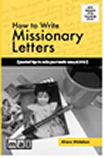|
|
MicHowt 07-10-106 How to
Write Missionary Letters Practical
tips to make your words come ALIVE! Alvera Mickelson Media
Associates International, 9th ed., 2007, 60 pp., ISBN 0-9623741-1-3 www.littworld.org
|
|
This helpful
little guide is aimed toward those who work across cultures a long way from
home. "Your
letters to friends and family back home have a profound effect on the cause
of world evangelization." A good
letter is the catalyst for prayer support and for enlarging the vision of
others for what God is doing in the world." (Prologue) If your letter
is unappealing and the first paragraph is dull, it will be put in the drawer
to be read leader. Later, when it is
pulled out with other such letters, it will be old and subsequently
discarded. The subconscious impression
is that missionary work is dull and unimpressive. Therefore you must attract and keep the
reader's attention. You letter must
look interesting and be interesting. (8-9) "Write
letters that are friendly, informative, honest and specific. Paint word pictures…. Give the reader something concrete to pray
for in your behalf." Add a
personal handwritten note. Write with
a particular read in mind. Write to
that person. (9-10) "1. What will interest the reader I have in
mind this month? 2. What does he or she need to know to gain a
penetrating view of my work? 3. How can I challenge him or her to pray
intelligently and consistently for the work over the next few months?
" (11) "The first
sentence in your letter is the most important. Strong beginning and memorable endings are
two essential principles for good prayer letters." (13) "Introduce
the main idea at once. Pose a
question. Begin with a story. Begin wtih a startling statement. Begin with a summary statement. Begin with a reference to a reader. (15-16)
Focus on one
idea or incident or one dominant idea and develop it. Maintain unity through the subject or
through an incident or through a theme. (17-18) Use variety
among letters. (21) Be dramatic. Develop a keen sense of sight, sense,
sound, taste and touch when you write. (23)
Avoid sermons. (24) Be clear.
Don't use pious phraseology. Aim for
simple, uncluttered sentences. (25)
Short paragraphs look more interesting and are easier to read.
(26) Assume your
letters are the only contact the reader has with missions. Be whole and honest. Keep them in touch with family but don't
let family dominate the letters.
"Be generous with stories about the people among whom you
work." (27) Be funny. Don't belittle. It is safest to make yourself the butt of
your jokes. (28) "Don't
paint glowing portraits of a work that doesn't really glow." (29) "Don't
crowd your letter. Use generous
margins, a minimum of 1 inch, on all four sides. One-page letters are much more likely to be
read. (31) Add
photographs. Use sharp dramatic shots
of someone doing something. (33-34) E-mail Letters People don't
read long emails. Make it one screen. Hide the names
and email addresses using the bcc field. Write to both
husband and wife. Use bullet
points sometimes. Send at regular
times, but not daily! Occasionally
give recipients an opportunity to unsubscribe. Proof read your
emails. They may be forwarded. Compress photos
to a reasonable size. Save copies in a
file as documentation of your ministry. (54-55) Many people
value paper over email. Use a balance
of both. Resources for
websites and blogs: |
|
* * * * *
